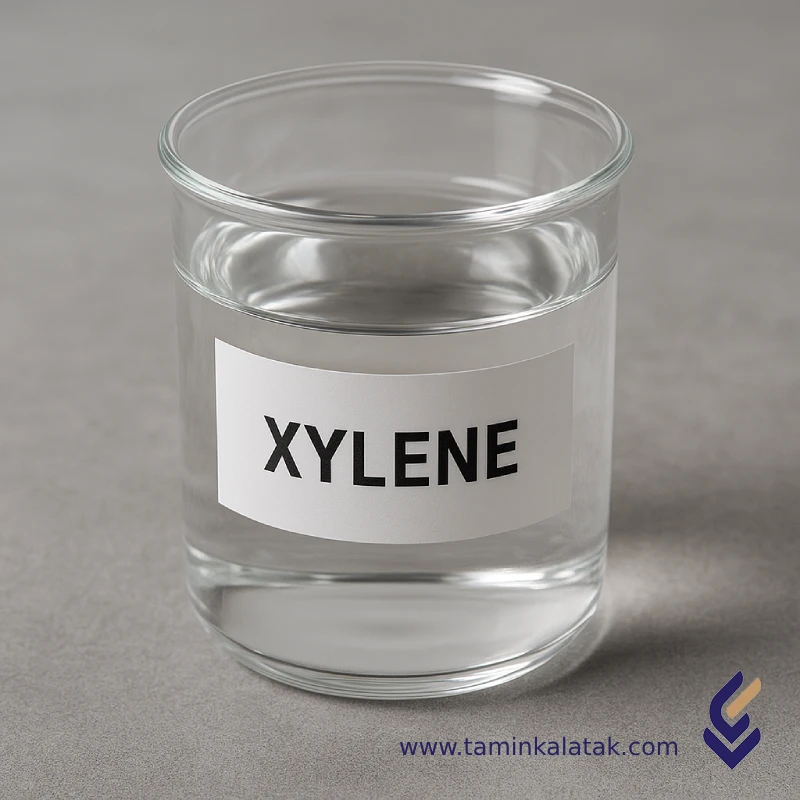xylene
Xylene is an aromatic hydrocarbon compound with the chemical formula C₆H₄(CH₃)₂ (or C₈H₁₀), consisting of a benzene ring substituted with two methyl (–CH₃) groups.
It exists in three structural isomers — ortho-xylene, meta-xylene, and para-xylene — as well as in the form of mixed xylene, which contains a mixture of these isomers along with a certain amount of ethylbenzene.
Due to its distinct physical and chemical properties, xylene is widely used across various industrial sectors.
Structure of Xylene
Xylene is an aromatic compound with the chemical formula C₆H₄(CH₃)₂.
It consists of a benzene ring (a six-membered ring with alternating double bonds) with two methyl groups attached at different positions.
Xylene exists in the following three isomeric forms:
-
Ortho-xylene (o-xylene): Methyl groups at positions 1 and 2 on the benzene ring.
-
Meta-xylene (m-xylene): Methyl groups at positions 1 and 3.
-
Para-xylene (p-xylene): Methyl groups at positions 1 and 4.
Each isomer exhibits distinct physical properties and industrial applications due to the positional differences of the methyl groups.
Physical and Chemical Properties of Xylene
-
Chemical Formula: C₆H₄(CH₃)₂
-
Appearance: Colorless liquid with a sweet, characteristic odor (similar to toluene)
-
Boiling Point: Approximately 138–144°C, depending on the isomer
-
Solubility: Slightly soluble in water (<20 mg/L), but highly soluble in organic solvents such as alcohol, ether, and benzene
-
Chemical Stability: Highly stable under normal conditions due to its aromatic structure
-
Flammability: Flash point around 27–30°C — highly flammable material
Applications of Xylene
-
Petrochemical Industry: Para-xylene is a key raw material for producing purified terephthalic acid (PTA), which is used in polyethylene terephthalate (PET) manufacturing.
-
Industrial Solvent: Used as a powerful solvent in paints, resins, adhesives, and coatings.
-
Plastics Industry: Para-xylene is used to produce plastic bottles and polyester fibers.
-
Pharmaceuticals: Utilized in the synthesis of certain chemical intermediates and active ingredients.
-
Printing Industry: Employed as a solvent in printing inks.
-
Laboratory Use: Commonly used for cleaning equipment and in chemical analysis.
Advantages of Xylene
-
Excellent Solvency: Capable of dissolving a wide range of organic compounds.
-
High Stability: Aromatic structure provides strong resistance to chemical degradation.
-
Isomeric Versatility: Multiple isomer forms enable diverse industrial applications.
-
Economic Production & Availability: A by-product of petroleum refining and catalytic reforming processes, making it widely accessible.
Disadvantages of Xylene
-
Toxicity: Prolonged exposure to xylene vapors may cause central nervous system, liver, and kidney damage.
-
Fire Hazard: Highly flammable liquid with vapors heavier than air.
-
Environmental Impact: Low biodegradability and potential for soil and groundwater contamination.
-
Health Limitations: Requires purification and FDA/EMA approval for use in food or pharmaceutical industries.
Safety and Handling of Xylene
-
Personal Protective Equipment (PPE): Use chemical-resistant gloves, safety goggles, and suitable respiratory protection in enclosed areas.
-
Ventilation: Ensure adequate ventilation in industrial workplaces to prevent vapor accumulation.
-
Storage Conditions: Store in tightly sealed containers, away from heat, sparks, and open flames.
-
Hazardous Contact Points: Eyes, skin, and respiratory system. In case of contact, rinse immediately with water.
Occupational Exposure Limits (OSHA / NIOSH)
-
Permissible Exposure Limit (PEL): 100 ppm (TWA)
-
Recommended Exposure Limit (REL): 100 ppm (TWA), 150 ppm (STEL)
Applications
| Applications | , , , |
|---|
xylene
| Solubility in water | Melting point | Density (at 20°C) | Physical appearance | Vapor pressure | Grade | CAS number | Chemical formula | Products |
|---|---|---|---|---|---|---|---|---|
| 0.015 – 0.020 g/L (very slightly soluble) | Mixture: ≈ -47°C o-Xylene: -25°C m-Xylene: -48°C p-Xylene: 13.2°C" | 0.86 – 0.88 g/cm³ | Colorless liquid with a sweet, characteristic odor. | 6 – 9 mmHg | Industrial grade Pure or analytical (≥99%) Petrochemical (Pure para-xylene for PET) | Mixture of isomers: 1330-20-7 Ortho-xylene: 95-47-6 Meta-xylene: 108-38-3 Para-xylene: 106-42-3 | Xylene – includes ortho, meta, para or mixed xylene | Xylene – includes ortho, meta, para or mixed xylene |







